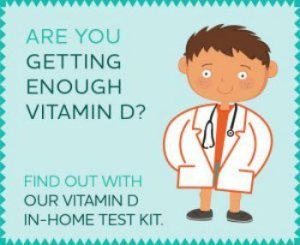Here's Your Complimentary
Fact Sheet On Vitamin D
Printer Friendly
Fact Sheet on
Vitamin D Here (PDF)
Why You Should Care
About Vitamin D
This Vitamin D Fact Sheet is a summary of what is finally being rediscovered as the health giving nutrient that it is. It seems that every day there is a new study telling about a new benefit that vitamin d has on your health. But while doctors today are finally realizing its importance, doctors over a hundred years ago were already using vitamin d as the MAINSTAY of their hospitals. These Sanitoriums boasted excellent success CURING people of fatal illnesses such as tuberculosis- using only the power of the sun and its life giving vitamin d.
Today, as doctors warn to stay out of the sun and chronic illnesses are becoming more and more prevalent, vitamin d is again in the spotlight. From MOUNDS of studies, we are discovering that up to 85% of people in western countries- including teenagers and pregnant and lactating women- are Vitamin D deficient; sometimes severely so! And with this severe vitamin d deficiency, we are only now realizing the connection between vitamin d deficiency and almost every chronic illness imaginable, such as:
- Breast Cancer
- Colon Cancer
- Chronic Pain
- Diabetes
- Multiple Sclerosis
- Osteoporosis
And much more. Researchers are making recommendations that doctors are being EXTREMELY slow to act upon. This Vitamin D Fact Sheet is an attempt to summarize the important practical aspects of taking Vitamin D properly and safely. Resources are given at the end if you would like to get more detailed information about the health benefits of Vitamin D and why it's important to be concerned about vitamin d for the rest of your life.
Fact Sheet On Vitamin D
Should You Take Supplements?
| Who Should and Should Not Take Vitamin D | ||
|---|---|---|
| Who SHOULD Take Vitamin D | Who Should NOT Take Vitamin D | |
| Age(ng/ml) |
| |
| Gender |
|
|
| Weight |
|
|
| Your Medical Conditions |
|
|
| Lifestyle Factors |
| |
| Skin Tone |
|
|
| Geographic Location |
|
|
| Dietary Preferences |
|
|
Vitamin D Levels
| Vitamin D Levels | |
|---|---|
| Who Should Get Their Vitamin D Levels Tested | The Fact Sheet on Vitamin D Suggests that Everyone should be tested every 3 months until levels are within the recommended ranges for 2 consecutive tests. After that, once per year with your annual physical. |
| How to get your Vitamin D Level Tested |
• Ask Your Physician specifically for a: 25 (OH)D Level- Also called a Hydroxyvitamin D Level
• Get an In Home Blood Spot Vitamin D Test No blood draw necessary
|
| What Should Your Vitamin D Level Be* (*please ignore the levels on the lab sheet from the doctor's office or hospital as these not up to date) |
|
| Excess Vitamin D and Overdoses |
|
View the Fact Sheet on Vitamin D
With Greater Ease
Printer Friendly Version (PDF)
Vitamin D Deficiency Treatment
| Vitamin D Deficiency Treatment | |
|---|---|
| Standard Vitamin D Deficiency Treatment (For levels less than the recommended 50 to 80 ng/ml) |
• 50,000 IU's per week *
OR
• Up to 10,000 IU's per day**
*Dr. Michael Holick
** 'The Use of Vitamin D in Clinical Practice'
|
| What FORM of Vitamin D Should You Take |
• Vitamin D3 – also called Cholecalciferol – Prescription Vitamin D is called Ergocalciferol or Vitamin D2
• Do NOT take Prescription Vitamin D2 ***
***'The case against ergocalciferol (vitamin D2) as a vitamin supplement'
|
| What about Overdosing !? | There has NEVER been a recorded case of overdose in an adult on dosages of 10,000 IU's per day or less taken for YEARS at a time. Children with rickets will get a dose of 600,000 IU's all at once! And in East Germany for over a decade, it was routine to give all newborn babies a dose of 600,000 IU's all at once. Vitamin D Overdose is extremely rare. |
Vitamin D Maintenance
This dosage is for when you have ALREADY had a lab test and your levels are within the optimal levels in the chart above!
| Vitamin D Maintenance Dosage | |
|---|---|
| Children |
|
| Teenagers and Women |
• Enough to keep Vitamin D Levels 'around' 50 ng/ml (158 nm/L) *– usually between 3800 to 5000 IU's per day
|
| Men |
• Enough to keep Vitamin D Levels 'around' 50 ng/ml (158 nm/L)* - usually about
5000 IU's per day
|
| The Elderly |
• Enough to keep Vitamin D Levels 'around' 50 ng/ml (158 nm/L)* - usually between 3800 to
5000 IU's per day
|
| Pregnant and Lactating Women |
• Enough to keep Vitamin D Levels 'around' 50 ng/ml (158 nm/L)*
Taking between 4000 IU's to 6800 IU's per day can help to reduce complications of pregnancy and to supply the baby with plenty of Vitamin D in breastmilk.
|
| What about Overdosing!? These dosages are almost TEN TIMES the RDA for Vitamin D |
There has NEVER been a recorded case of overdose in an adult on dosages of 10,000 IU's per day or less taken for YEARS at a time. Children with rickets will get a one-time dose of 600,000 IU's! And in East Germany for over a decade, it was routine to give all newborns babies a dose of 600,000 IU's all at once. Vitamin D Overdose is extremely rare. |
Back to Top of Fact Sheet on Vitamin D
To Easy Immune Health Home



